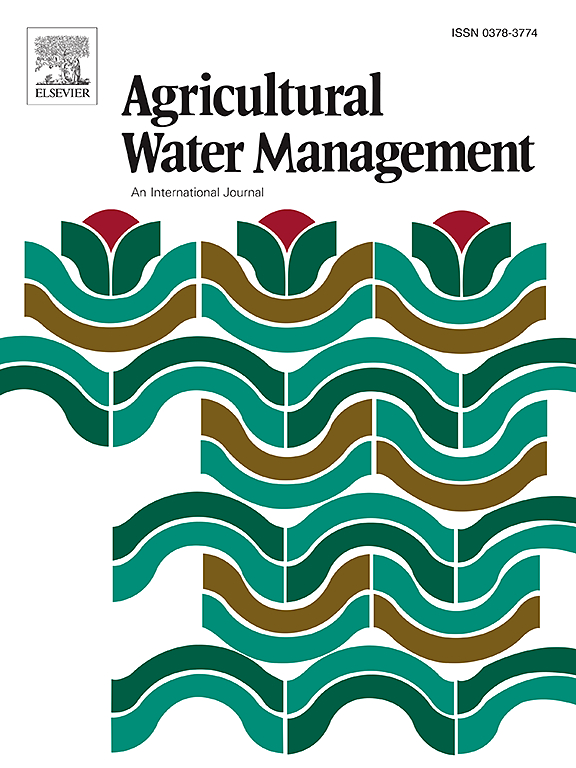Dry matter accumulation, translocation, and bulb yield of short-day onion as affected by cultivars and drip irrigation regimes in the dry-hot regions of southwest China
IF 5.9
1区 农林科学
Q1 AGRONOMY
引用次数: 0
Abstract
Seasonal water scarcity and improper cultivar selection have severely restricted the production potential of short-day onions in the dry-hot regions of southwest China. However, the appropriate irrigation regime and cultivar are still unclear. Therefore, field experiments were conducted during the two onion growing seasons (2022–2023 and 2023–2024) to evaluate the effects of irrigation levels [full irrigation (W1: 100 %ETc) and three deficit irrigation levels (W2: 80 %ETc, W3: 60 %ETc and W4: 40 %ETc); where ETc was crop evapotranspiration] on aboveground dry matter accumulation, partitioning, translocation, bulb yield and irrigation water productivity (WPI) of different onion cultivars [a local traditional cultivar (C1: Hongshuai) and two new cultivars (C2: Niu 4 and C3: Shahu)]. The results showed that the logistic growth model could effectively fit the process of dry matter accumulation in onions. C2 and C3 reduced aboveground dry matter accumulation, maximum accumulation rate of dry matter (ARmax), and average accumulation rate of dry matter (ARavg), but increased bulb yield and WPI when compared with C1. Notably, C2 had the highest bulb yield and WPI in the two growing seasons. Deficit irrigation decreased dry matter accumulation after bulb initiation (DMAI), but increased bulb dry matter proportion and dry matter translocation (DMT). Bulb yield under W1 and W2 had insignificant difference, but W2 enhanced WPI. Although W3 and W4 significantly increased WPI, bulb yield decreased significantly. Bulb dry matter had significantly positive correlation with DMAI. Comprehensively considering bulb yield and WPI, the ‘Niu 4’ cultivar was preferred and an irrigation amount of 80 %ETc (onion evapotranspiration) was recommended for onions production in the dry-hot regions of southwest China. By optimizing the irrigation strategy of onions, WPI can be improved without significantly reducing bulb yield, which is of great practical significance for dry-hot regions with water scarcity. This study can provide a theoretical basis for optimizing onions irrigation management and cultivar selection in the dry-hot regions.
西南干热地区不同品种和滴灌方式对短日洋葱干物质积累、转运和鳞茎产量的影响
季节性缺水和品种选择不当严重制约了西南干热地区短日洋葱的生产潜力。然而,适当的灌溉制度和品种仍不清楚。为此,在2022-2023和2023-2024两个洋葱生长季节进行了田间试验,评价了不同灌溉水平[满灌(W1: 100 %等)和亏缺灌(W2: 80 %等、W3: 60 %等和W4: 40 %等]对洋葱生长的影响;其中ETc为作物蒸散]对不同洋葱品种[1个地方传统品种(C1:红帅)和2个新品种(C2:牛4号和C3:沙虎)]地上干物质积累、分配、转运、鳞茎产量和灌溉水生产力(WPI)的影响。结果表明,logistic生长模型能有效拟合洋葱干物质积累过程。与C1相比,C2和C3降低了地上部干物质积累量、最大干物质积累速率(ARmax)和平均干物质积累速率(ARavg),但提高了鳞茎产量和WPI。值得注意的是,C2在两个生长季节中鳞茎产量和WPI最高。亏缺灌溉减少了鳞茎形成后的干物质积累,但增加了鳞茎干物质比例和干物质转运(DMT)。W1和W2处理下鳞茎产量差异不显著,但W2提高了WPI。虽然W3和W4显著提高了WPI,但鳞茎产量显著降低。鳞茎干物质与DMAI呈极显著正相关。综合考虑鳞茎产量和WPI,建议“牛4号”品种在西南干热地区生产洋葱时,灌溉水量为80% %(洋葱蒸散)。通过优化洋葱灌溉策略,可以在不显著降低洋葱鳞茎产量的前提下提高洋葱WPI,这对缺水干热地区具有重要的现实意义。本研究可为干热地区洋葱灌溉管理和品种选择的优化提供理论依据。
本文章由计算机程序翻译,如有差异,请以英文原文为准。
求助全文
约1分钟内获得全文
求助全文
来源期刊

Agricultural Water Management
农林科学-农艺学
CiteScore
12.10
自引率
14.90%
发文量
648
审稿时长
4.9 months
期刊介绍:
Agricultural Water Management publishes papers of international significance relating to the science, economics, and policy of agricultural water management. In all cases, manuscripts must address implications and provide insight regarding agricultural water management.
 求助内容:
求助内容: 应助结果提醒方式:
应助结果提醒方式:


